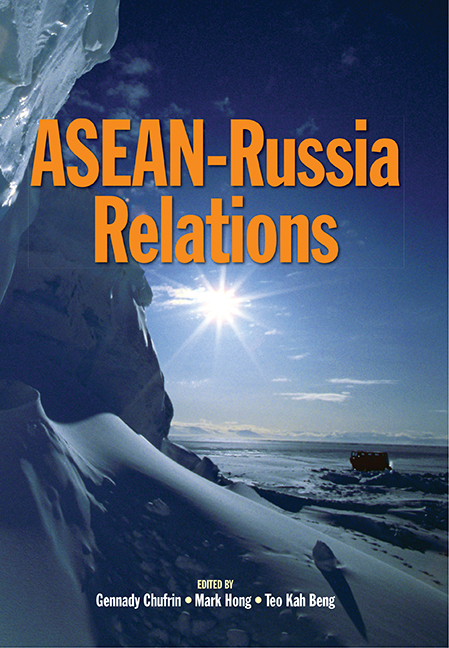Book contents
- Frontmatter
- Contents
- Foreword
- Foreword
- Opening Address
- Opening Address
- The Contributors
- Part I Overview of ASEAN-Russia Relations
- Part II Bilateral Relations
- Part III Security Issues in Southeast Asia
- Part IV Bilateral Economic Relations
- 8 Singapore-Russia Economic Relations
- 9 Russia-Singapore Relations: Thirty-seven Years of Cooperation and Dialogue
- 10 Rationale for a Free Trade Agreement between Russia and Singapore and Russia-ASEAN
- 11 Russia-ASEAN: Problems and Prospects of Economic Cooperation
- Index
9 - Russia-Singapore Relations: Thirty-seven Years of Cooperation and Dialogue
from Part IV - Bilateral Economic Relations
Published online by Cambridge University Press: 09 November 2017
- Frontmatter
- Contents
- Foreword
- Foreword
- Opening Address
- Opening Address
- The Contributors
- Part I Overview of ASEAN-Russia Relations
- Part II Bilateral Relations
- Part III Security Issues in Southeast Asia
- Part IV Bilateral Economic Relations
- 8 Singapore-Russia Economic Relations
- 9 Russia-Singapore Relations: Thirty-seven Years of Cooperation and Dialogue
- 10 Rationale for a Free Trade Agreement between Russia and Singapore and Russia-ASEAN
- 11 Russia-ASEAN: Problems and Prospects of Economic Cooperation
- Index
Summary
HISTORY BACKGROUND
Singapore and the former Soviet Union established full diplomatic relations on 1 June 1968. A joint statement described the moves as a “further step towards maintaining close and friendly relations” between both countries. Singapore's first Prime Minister, Mr Lee Kuan Yew visited Moscow in 1962, even before Singapore became independent in August 1965, to lobby for Soviet support for the creation of Malaysia, of which Singapore was a member from 1963–65. In November 1965, Singapore's then Deputy Prime Minister, Dr Toh Chin Chye, made the first official visit to the former Soviet Union. Following Dr Toh's visit, a Trade Agreement was signed in April 1966. Trade Representation Offices were subsequently established in Moscow and Singapore. The first Soviet Ambassador to Singapore, Mr Ilya I. Safronovich, was appointed in January 1969. Singapore appointed its first Ambassador to the former Soviet Union, the late Mr P. S. Raman, in July 1971.
High level official visitors from Singapore have included Mr Lee Kuan Yew (1990) and the Speaker of Parliament, Mr Tan Soo Khoon (1997), Foreign Minister Prof. S. Jayakumar in September 2002, Minister for Trade and Industry George Yeo in 2004, whilst several Russian Ministers have visited Singapore, such as Foreign Ministers Primakov and Igor Ivanov for the ASEAN Post Ministerial meetings. The most recent visit was in October 2003, by F.M. Ivanov.
During the Cold War era, Singapore pragmatically continued to cooperate with the USSR in trade and economic cooperation, by forming several joint ventures. From independence in 1965, Singapore had felt that the USSR could play a role in the power-balance in Southeast Asia, but this view changed after the signing of the Soviet-Vietnam Treaty of Friendship and Cooperation in 1978, and the establishment of a Soviet naval base in Camranh Bay in Vietnam, and the Soviet support given to Vietnam for its invasion and occupation of Cambodia, seen as a threat to regional security.
- Type
- Chapter
- Information
- ASEAN-Russia Relations , pp. 65 - 70Publisher: ISEAS–Yusof Ishak InstitutePrint publication year: 2006



